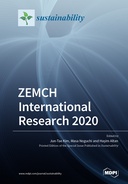Explore

ZEMCH International Research 2020
0 Ungluers have
Faved this Work
Login to Fave
Globally, record weather temperatures and changing climatic patterns, attributed partly to energy use and related carbon dioxide (CO2) emissions, indicate that the issue of global warming cannot be marginalized. In most countries buildings account for a significant share of the total final energy consumed and are responsible for associated CO2 emissions. In response to market needs and demands for social, economic, and environmental sustainability of housing in developed and developing countries, the Zero-Energy Mass Custom Home (ZEMCH), integrating lean design and sustainable construction concepts, was envisaged and discussed internationally. To deliver a marketable and reliable near-zero-energy/emission-conscious mass custom home, various key design, technological, production and marketing, and delivery and operational parameters need to be optimized harmoniously. This book compiles recent research articles of ZEMCH International Research 2020. A wide range of ZEMCH topics, including building envelope evaluations, occupant choice and experience, indoor environmental quality, automated control systems, mass customization, and integration of renewable energy, on both building and urban scales are covered. It aims to address current questions as well as present challenges and opportunities for continuous development of built environments for users with diverse socio-economic backgrounds and cultural differences in developed and developing countries.
This book is included in DOAB.
Why read this book? Have your say.
You must be logged in to comment.
Rights Information
Are you the author or publisher of this work? If so, you can claim it as yours by registering as an Unglue.it rights holder.Downloads
This work has been downloaded 90 times via unglue.it ebook links.
- 90 - pdf (CC BY) at Unglue.it.
Keywords
- AHU (air handling unit)
- air-type PVT collector
- Apartment houses
- balcony photovoltaic system
- BESS (battery energy storage system)
- BIPVT (building-integrated photovoltaic/thermal)
- building energy audit
- building envelope thermal defects
- building height diversity
- CFD (computational fluid dynamic)
- confinement effects
- construction defects
- construction quality
- contaminant control
- customer integration
- demographics
- domestic environment
- double windows
- dual-fluid
- dynamic building simulation
- dynamic energy performance gap
- energy
- energy dissipation
- energy labeling program for windows
- energy performance gap
- Environmental factors
- existing building
- fertility intention
- glass-to-glass
- History of engineering & technology
- Housing
- housing expectation
- Housing policy
- housing situation
- impacts
- mass customisation
- Mass Customization
- mock-up experiment
- model validation
- new construction
- newlyweds
- occupants’ experiences
- operation modes
- optical sensing
- overall thermal transmittance of windows
- particulate matter
- POE study
- post-occupancy
- practices
- PV/T system
- qualitative analysis
- reinforced concrete column
- residential
- residential satisfaction
- simulation
- simulation model validation and calibration
- social housing
- Socioeconomics
- spatial factors
- sustainability and livability of neighborhoods
- sustainable indoor environment
- sustainable solar shading
- sustainable urban environments
- Technology, engineering, agriculture
- Technology: general issues
- theoretical relationship
- thermal and electrical efficiency
- thermal bridging
- thermal performance
- thermography
- triangular baffles
- UAE
- United Arab Emirates
- zero-energy houses
Links
DOI: 10.3390/books978-3-0365-2851-9Editions

